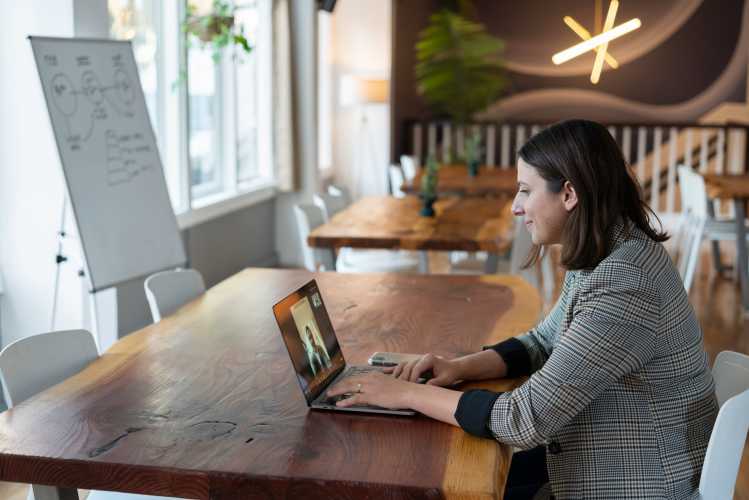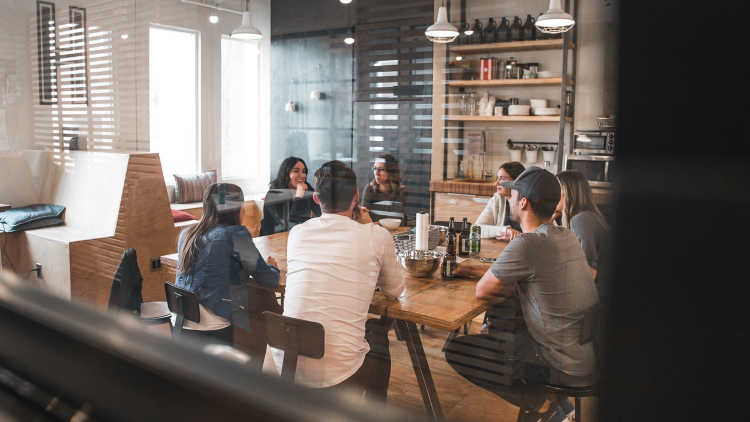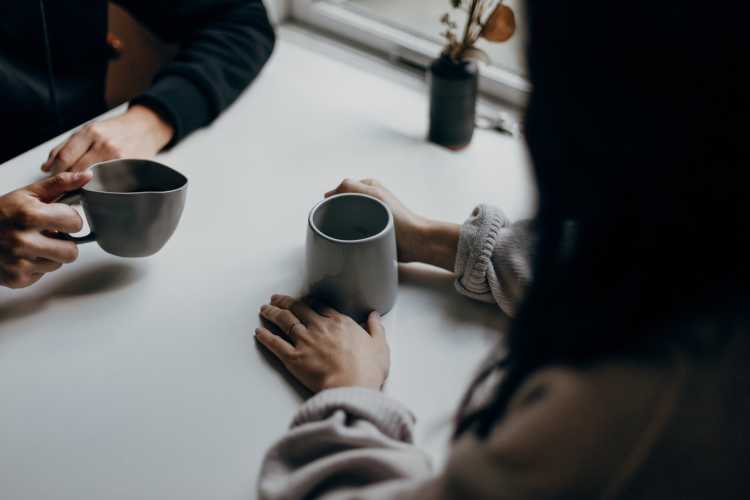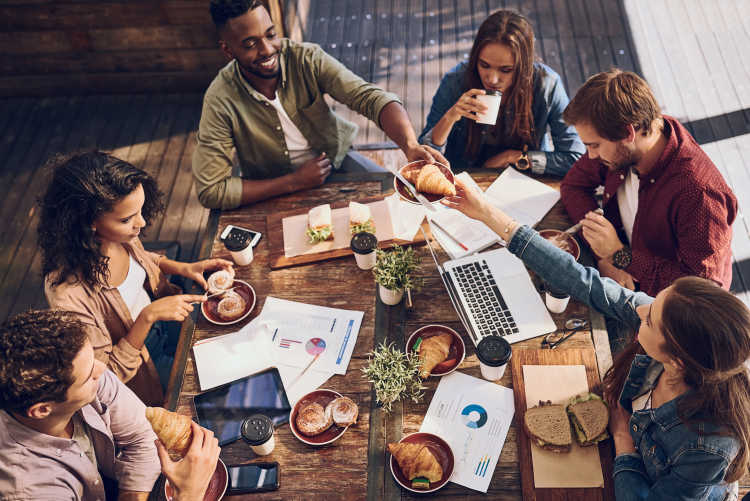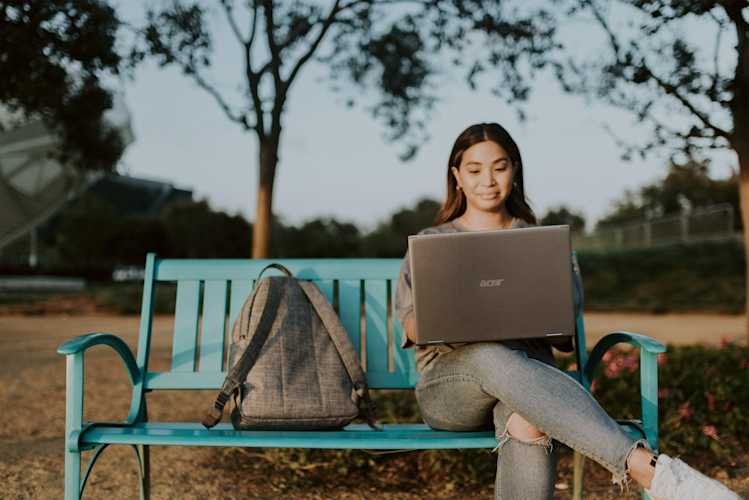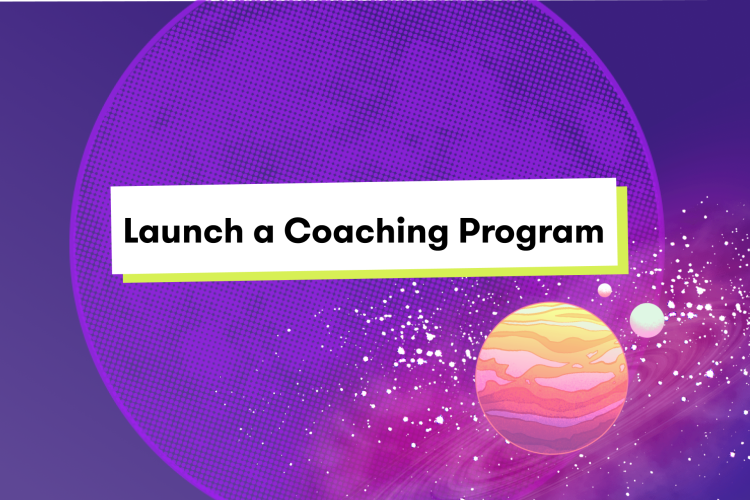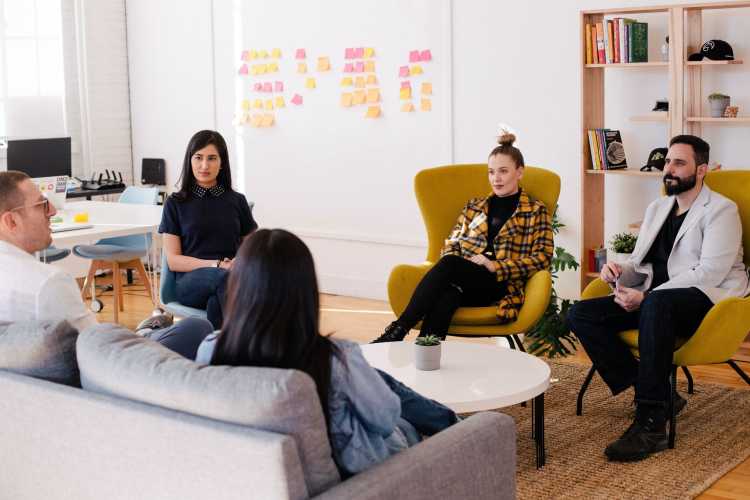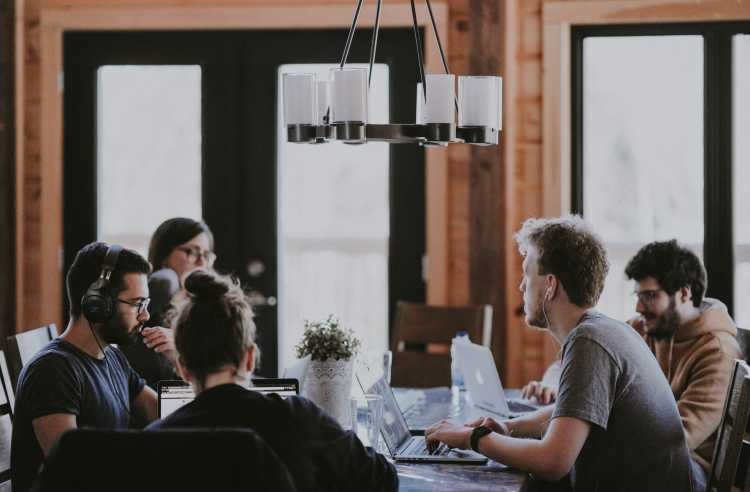Coaching
How to Build a High-Ticket Coaching Funnel
If you're building a coaching business, a funnel can help you find clients. Here's how.
Author
Last Updated
February 6, 2025

Table of Contents
If you’re a coach, you probably know that high-ticket coaching products can be the recipe for a profitable, heck even lucrative, coaching business. It you’re tired of giving your best stuff away for way less than it’s worth, a high-ticket product might be just the ticket (Sorry – couldn’t resist).
Creating a high-ticket offer for either 1:1 or group coaching can be easy to do. But the question always is, “How do I get people to buy this?”
In this article, we’re going to talk about one of the tried-and-true methods: funnels. We’ll walk you through the basics of sales funnels for coaches, and give you a step-by-step guide to build a high-ticket coaching funnel that actually sells your offer.
Let’s go!
If you want more support in building your online course and community, come join OUR Mighty Community for free and meet other new and established community owners! We’d love to meet you. Join for free!
Step 1: Identify your Ideal Client
The first step to any coaching funnel, long before you get to the actual building, is to know who it’s for. A funnel without an ideal client will waste your advertising dollars and might bring in the wrong people.
So decide clearly who your ideal client is. Who are they? Where do they live? What do they do? What are their likes and dislikes? What are they passionate about?
You can even build an avatar of this ideal client – sketch a little picture of them and give them a name! It’s great exercise.
Here are some examples of what a razor-sharp image of your Ideal Client looks like.
People who are unhappy in their job (Too Broad) - Millennial women who want to break into management roles for the first time (Better!)
People who want to lose weight (Too Broad) - Middle-aged men who want to start weight lifting for the first time (Better!)
People who are starting a business (Too Broad) - Locally-owned, small businesses that want to generate new customers from Facebook ads (Better!)
You can’t create a great funnel until you know who it’s for.
One other important thing to ask is – who can afford high-ticket coaching? When you’re selling a high-ticket product, you should also think about income. Selling a $2,000 career coaching program to people who are currently unemployed might not work.
You might decide that you are going to go for clients who currently make over $100k/year. Ultimately, it’s up to you. But an ideal client is always someone who can afford to buy.
It’s important to identify a need, but also someone who can afford your high-ticket program.
Step 2: Reach into your story
The second secret to serving these ideal clients is to reach into your story. Why are you the best person to help them?
Often it’s these types of stories, not the great offer, that really make a funnel work. It means more when you can say:
I know how to fix your problem, I used to have it.
I know how to help you, I’ve helped thousands of others.
I know how to get to the next level. I’ve done it.
Reach into your story. Who are you? Why are you qualified to help people? Start from that story and you’ll have the making of a great funnel.
Let’s revisit those examples from above and imagine how your story could help you sell to each of those people:
“I found as a millennial woman, it was really hard to break the glass ceiling. So when I hit management, I decided to help other women do it.” (Millennial women who want to break into management roles for the first time.)
“I spent my weekends sitting on the couch. Everything hurt and I got winded going up a flight of stairs. Then I started lifting weights. This year, I competed in a body-building competition and I decided to help others.” (Middle-aged men who want to start weight lifting for the first time.)
“I saw my favorite local coffee roaster was about to go under. So I used my marketing skills to build Facebook ads and now there’s a line out the door.” (Locally-owned, small businesses that want to generate new customers from Facebook ads.)
Your story is one of the most powerful features of your funnel. Don’t neglect it.
Step 3: Build your value ladder
If you’ve got a clear ideal client and you know why you’re the person to help them, the next step is the what. What is your value proposition?
Sometimes you can jump straight to a high-ticket sale, but usually it takes work to show that you're the right person to help your ideal clients. You can show this by moving potential clients through a value ladder.
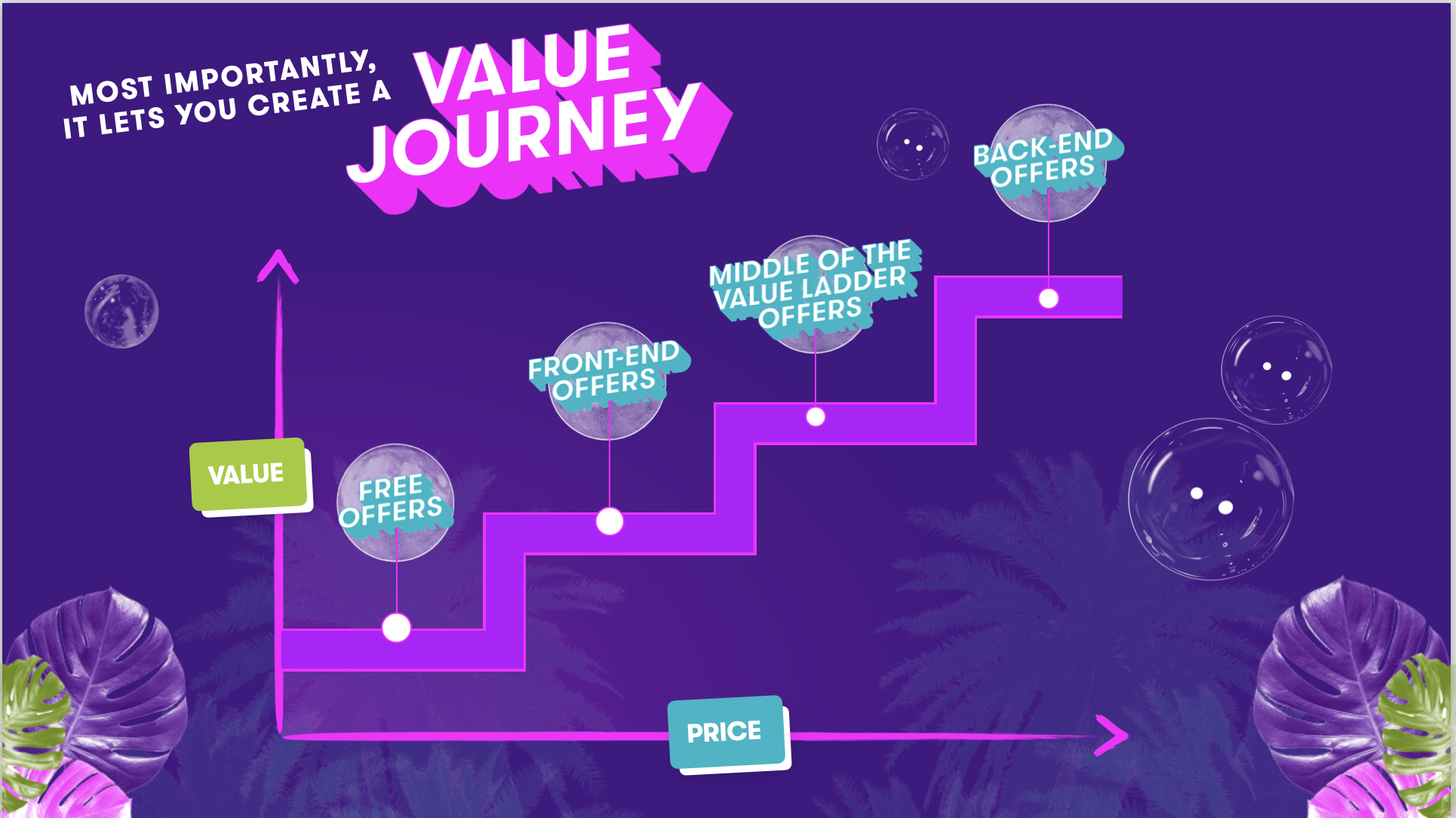
Give value first
For many of your warm leads coming into your funnel, the first value proposition might not be a high-ticket course. It might be a free PDF that helps them solve a problem. It might be a free webinar that they watch, get a ton of value from, and meet you.
Often your ideal clients need a bit of time to see that you’re the one they trust to help them with their problem. There are a lot of empty promises on the internet. So start by giving value first. Over-deliver on the free stuff and lead generation (more on this below). When they see you knock it out of the park with the little things, they’ll be more likely to come back for the big ticket items.
Consider a smaller product sale
A lot of online marketers swear by what they call a “tripwire” product. A tripwire is basically a small purchase that customers make. Research shows that people who buy from you will continue to buy from you – if your stuff is good. The hardest sale to make is the first one.
That’s why marketers often use a low-cost, tripwire product to make a sale. When people have spent $5 with you, and realized it was a great investment, they’re way more likely to spend $500.
You might have a low-cost book or training session you sell that gets people used to buying from you.
Present a clear, high-ticket value proposition
When it comes to making a high-ticket coaching sale, present a really clear value proposition. One of the best ways to do this is with what we call a Big Purpose Statement. We use it for selling communities, but it works for high-ticket products too. A Big Purpose Statement names the transformation you’re going to take clients on. It looks like this:
With the big purpose statement in hand, you’ve got the pieces to build an offer people will love.
Let’s come back to our three examples from above and turn them into a Big Purpose Statement:
I help millennial women shatter the glass ceiling so that they can move into management, have a bigger impact, and earn what they’re worth!
I help out-of-shape, middle aged men get off the couch and fall in love with working out so that they have more energy, feel great in their bodies, and can show up for the people they care about.
I teach local businesses to build beautiful ad campaigns on Facebook so they can get awesome, repeat customers who rave about their products/services.
Name the offer
If you’ve done this hard work, all that’s left is the HOW. How do you create the transformation? That’s where the offer comes in. For each of the three examples above, we could imagine a high-ticket coaching offer that helps the ideal clients achieve their goals!
Is it a 5-week bootcamp? A 6-month mastermind? An intensive 1:1 weekly session mixed with community membership? Create an offer that fits your clients’ goals and lives.
Step 4: Craft your funnel
Stop. Funnel time. (Are you old enough to get the MC Hammer reference?)
It’s time to build the funnel. There are different types of funnels you can use, and too many to name here. If you check out an awesome product like ClickFunnels, you’ll have what you need. Here are a few funnels you can try.
Squeeze Funnel
The first funnel most of your customers will see! A squeeze funnel AKA lead magnet AKA opt-in is where most of your customers start their journey. It’s the point where they give you their email in exchange for a goodie: a free training, a PDF, an email course, etc.
It looks like this:
Squeeze page (with offer)
Thank you
Webinar Funnel
One tried and true method for selling high-ticket coaching is with a webinar. The reason? Because with a webinar you get in front of people, build trust (video goes a long way here), AND show that you understand and are able to help solve their problem. With a video, people can say “Yeah, I’d work with that person,” which is much harder to get from written content.
The webinar should give value. Not everyone is going to buy right now, and even if people don’t, you want them to walk away seeing that you’re the person who will help them – especially if they decide to spend in the future.
A webinar funnel looks like this:
A registration pag
A thank you page
A link or invite to attend the webinar (it’s also possible to skip the thank you page and go straight to the webinar)
An offer
Sales Funnel
There are different types of sales funnels, but you might choose to create one and have your offer in it. This would mean you’re not offering a webinar first, but going straight to the offer.
There are different ways to create an actual product offer funnel, but for a high-ticket product, consider a video sales letter funnel. This would require recording a video telling your story, making the pitch, and having a clear call to action. Video is awesome and people react well to it, but if you’re really not comfortable on camera you could replace this with a written sales letter page.
Here’s a sample funnel that can work for selling a product:
A video sales letter page
An offer page
An upsell or downsell page
Step 4: Learn and adapt
One of the secrets to creating a high-ticket coaching funnel is to learn and adapt as you go. No funnel is going to be perfect the first time. You can experiment with your audience selection, with the copy, and with different types of funnels until you get something that works well.
You can also do an A/B test to experiment with your funnels and identify the most profitable.
And here’s a pro tip. Don’t let the success or failure of one funnel define you. It’s normal to have a funnel that doesn’t perform amazing the first time, and it’s tempting to think, This means people don’t want my offer.
Keep going.
Don’t quit.
It’s about finding the right people and the right way to sell to them. And almost nobody gets this right the first time.
Conclusion
We hope this guide has you really excited to build a high-ticket coaching funnel. Remember, funnel-building is a skill that can be learned with time. Don’t give up. And when you find a funnel that works well, milk it for all it’s worth!

If you’re looking for an amazing platform to host your coaching business, come give Mighty Networks a try. You can easily build a coaching community you can charge for, launch live and pre-recorded courses, host masterminds and group coaching, and create cool live events! With features like live streaming, multi-currency payments, and total flexibility to create plans and bundles, it’s the perfect place to grow your coaching business.
Ready to launch your coaching business?
Ready to start building your community?
Start a free 14-day trial to explore Mighty—no credit card required.
More like this
Join Mighty Community
Learn the principles of Community Design™ (and see them in action) alongside thousands of creators and entrepreneurs. It's free to join!

Online Courses
Creating a Course
Teaching a Course
Course Platforms
Selling a Course
Communities & Memberships
Community Platforms
Managing a Community
Building a Community
Growing a Community
Monetizing a Community
Content Creation
Creators & Entrepreneurs
Monetization
Content Creation
Starting a Business
Website Builders
Creating & Managing a Website
Events
Event Platforms
Hosting & Marketing Events
Branded Apps
Creating a Mobile App
Coaching Apps
Community Apps
Coaching
Mastermind Groups
Starting a Coaching Business
Coaching Platforms
Filter by Category
Online Courses
Communities & Memberships
Creators & Entrepreneurs
Events
Branded Apps
Coaching

